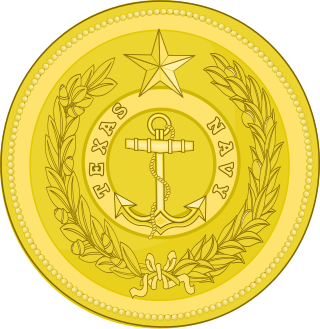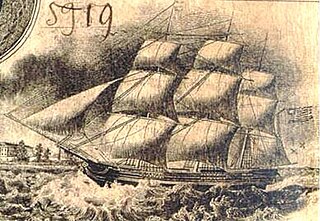Related Research Articles

The Texas Navy, officially the Navy of the Republic of Texas, also known as the Second Texas Navy, was the naval warfare branch of the Texas Military Forces during the Republic of Texas. It descended from the Texian Navy, which was established in November 1835 to fight for independence from Centralist Republic of Mexico in the Texas Revolution. The Texas Navy, Texas Army, and Texas Militia were officially established on September 5, 1836 in Article II of the Constitution of the Republic of Texas. The Texas Navy and Texas Army were merged with the United States Armed Forces on February 19, 1846 after the Republic of Texas became the 28th state of the United States.

The Texan schooner Brutus was one of the four ships of the First Texas Navy (1836–1838) that during the Texas Revolution wreaked havoc on towns along the coast of Mexico, blockaded Mexican ports, and captured ships bound for Mexico with goods and munitions of war.
The Texas schooner Invincible was one of the four schooners of the Revolutionary Texas Navy (1836-1837). She began her service in January 1836 and immediately began attacking ships supplying the Mexican army in Texas, including capturing the United States merchant vessel Pocket and later the British ship Eliza Russell. Both of these actions caused diplomatic incidents between the Republic of Texas and the United States and the United Kingdom.

The Texas schooner Liberty was one of the four schooners of the First Texas Navy (1836–1838). She served in the Texas Navy for only about 6 months, capturing the Mexican brig Pelicano loaded with weapons for their army in Texas. Later that year, she sailed to New Orleans accompanying the wounded Sam Houston, where she was repaired. Texas was unable to pay for the repairs and the ship was sold in June, 1836, to pay for the cost of the repairs. This left the Texas Navy with only three ships.
The Texan schooner Independence was one of the four schooners of the First Texas Navy (1836–1838). At the direction of Texas Governor Henry Smith, in 1836 Charles Hawkins took command of United States revenue cutter Ingham acquired by the Texas Navy and renamed Independence.

The Texan brig Wharton was a two-masted brig of the Second Texas Navy from 1839 to 1846. She was the sister ship of the Archer. Accompanying the Texas flagship, Austin, she defeated a larger force of Mexican Navy steamships in the Naval Battle of Campeche in May 1843. Transferred to the United States Navy in 1846, she was sold for $55.

The Texan sloop-of-war Austin was the flagship of the Second Texas Navy from 1840 to 1846. Commanded by Commodore Edwin Ward Moore, she led a flotilla in the capture of Villahermosa in 1840. After a period of inaction in port, Austin participated in the Naval Battle of Campeche in 1843. Austin was transferred to the United States Navy when Texas joined the United States in 1845, but was run aground and broken up in 1848.

The Naval Battle of Campeche took place on April 30, 1843, and May 16, 1843. The battle featured the most advanced warships of its day, including the Mexican steamer Guadalupe and the equally formidable Montezuma which engaged a squadron of vessels from the Second Republic of Yucatán and the Republic of Texas. The latter force consisted of the Texas Navy flagship sloop-of-war Austin, commanded by Commodore Edwin Ward Moore, the brig Wharton, and several schooners and five gunboats from the Republic of Yucatán, commanded by former Texas Navy Captain James D. Boylan.
The United States Revenue Cutter Ingham was one of the 13 Coast Guard cutters of the Morris-Taney class. Named for Secretary of the Treasury Samuel D. Ingham, she was the first United States warship to engage a Mexican ship in combat; and for her service in that battle, a newspaper called her Semper Paratus, which later became the motto of the United States Coast Guard. Ingham was sold in 1836 to the Republic of Texas and served in the Texas Navy until she was captured as a prize-of-war by Mexico and was rechristened Independencia.

The Texan schooner San Jacinto was a two-masted schooner of the Second Texas Navy from 1839 to 1840. She was the sister ship of the San Antonio and the San Bernard. In 1840, San Jacinto was part of the Texas Navy flotilla led by Commodore Edwin Ward Moore which was dispatched to assist Yucatecan rebels that had taken up arms against Mexico. In a storm, San Jacinto ran aground at Cayos Arcas and was wrecked. The crew were rescued by the flagship Austin.

The Texan schooner San Antonio was a two-masted schooner of the Second Texas Navy from 1839-1840. She was the sister ship of the San Jacinto and the San Bernard. In 1840, San Antonio was part of the Texas Navy flotilla led by Commodore Edwin Ward Moore which was dispatched to assist Yucatecan rebels that had taken up arms against Mexico. In February 1842, while re-provisioning in New Orleans, the crew of the San Antonio mutinied and the Lieutenant was killed. This was the only mutiny in the history of the Texas Navy. That fall, the San Antonio sailed for Campeche and was never heard from again.

The Texan schooner San Bernard was a two-masted schooner of the Second Texas Navy from 1839-1840. She was the sister ship of the San Jacinto and the San Antonio. In 1840, San Antonio was part of the Texas Navy flotilla led by Commodore Edwin Ward Moore which was dispatched to assist Yucatecan rebels that had taken up arms against Mexico. Returning to the Yucatan in 1841, San Bernard assisted in the capture of three Mexican prizes. Upon return to Galveston, San Bernard was driven ashore and was not repaired. When Texas joined the United States in 1846, San Bernard was transferred to the United States Navy and then sold for $150.

The Texian Army, also known as the Revolutionary Army and Army of the People, was the land warfare branch of the Texian armed forces during the Texas Revolution. It spontaneously formed from the Texian Militia in October 1835 following the Battle of Gonzales. Along with the Texian Navy, it helped the Republic of Texas win independence from the Centralist Republic of Mexico on May 14, 1836 at the Treaties of Velasco. Although the Texas Army was officially established by the Consultation of the Republic of Texas on November 13, 1835, it did not replace the Texian Army until after the Battle of San Jacinto.

The Battle of the Brazos River was an engagement fought in the Brazos River on April 17, 1837, between the Mexican Navy and the Texian Navy.

The Battle of Galveston Harbor, or the Battle of Galveston Bay was a naval engagement between the Republic of Texas and Mexico in Galveston Harbor on August 26, 1837. After the end of the Texas Revolution in 1836, Mexico and the newly declared Republic of Texas sporadically fought at sea. Texas was hoping to gain independence, while Mexico was hoping to reassert control over Texas.

The Ingham Incident, or the Montezuma Affair, was a naval battle fought in 1835, the first between Mexico and the United States. The Mexican warship Montezuma patrolled the coast of Texas to prevent the smuggling of contraband into the territory. During the cruise, the Mexicans captured the American merchant ship Martha and later the Texan ship Columbia which led to a response by the United States Revenue-Marine revenue cutter USRC Ingham. A bloodless engagement was fought on June 14, and ended when the Montezuma was purposely run aground to prevent capture.

The Texian Navy, also known as the Revolutionary Navy and First Texas Navy, was the naval warfare branch of the Texian armed forces during the Texas Revolution. It was established by the Consultation of the Republic of Texas on November 25, 1835. Along with the Texian Army, it helped the Republic of Texas win independence from the Centralist Republic of Mexico on May 14, 1836 at the Treaties of Velasco. It was replaced by the Texas Navy on March 23, 1839.

The Texan brig Potomac was a ship of the Second Texas Navy that never sailed as a warship. For a while, in 1838, she was the only ship in the Texas Navy. She was decommissioned in 1843.
Fort Velasco was a small circular palisade fort built by a garrison of Mexican soldiers at Velasco, Texas at the present-day location of Surfside Beach on the northeast bank at the mouth of the Brazos River and Texas Gulf Coast. The name also applies to at least three other forts built at almost the same location, one during the Texas Revolution, and two during the Civil War.

The Mexican Navy paddle frigate Guadalupe was the flagship of the Mexican Navy from 1842 to 1847. She participated in the Naval Battle of Campeche in 1843. She was one of the first iron-hulled warships ever built and one of the first to see action in a naval battle.
References
- ↑ "Official Website of the Texas Navies". Archived from the original on October 1, 2011. Retrieved July 16, 2011.
- 1 2 3 "Invincible". Handbook of Texas Online. Texas State Historical Association. Archived from the original on November 25, 2010. Retrieved 2007-09-25.